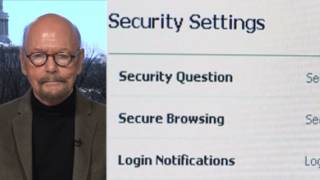
Topics
More than two years ago Congress halted plans for a controversial plan called Total Information Awareness to create the world’s largest surveillance database to track your phone calls, purchases, Internet usage, reading material, banking transactions. The National Journal has now revealed the program has quietly continued inside the NSA. [includes rush transcript]
In 2003, lawmakers voted to shut down Total Information Awareness–a program that developed technologies to predict terrorist attacks by mining government databases and the personal records of people in the United States.
Months earlier New York Times columnist William Safire had warned about the dangers of the program. In a column headlined “You Are A Suspect” Safire wrote:
“If the Homeland Security Act is not amended before passage, here is what will happen to you:
“Every purchase you make with a credit card, every magazine subscription you buy and medical prescription you fill, every Web site you visit and e-mail you send or receive, every academic grade you receive, every bank deposit you make, every trip you book and every event you attend — all these transactions and communications will go into what the Defense Department describes as 'a virtual, centralized grand database.'
“To this computerized dossier on your private life from commercial sources, add every piece of information that government has about you — passport application, driver’s license and bridge toll records, judicial and divorce records, complaints from nosy neighbors to the F.B.I., your lifetime paper trail plus the latest hidden camera surveillance — and you have the supersnoop’s dream: a “Total Information Awareness” about every U.S. citizen.
“This is not some far-out Orwellian scenario. It is what will happen to your personal freedom in the next few weeks if John Poindexter gets the unprecedented power he seeks.”
Following public outcry, the program was halted primarily because of privacy concerns, but also because its main advocate was John Poindexter, known for his involvement with the Iran-Contra scandal of the 1980s.
It now appears that the project “was stopped in name only” and that TIA is in fact continuing. The National Journal reports that TIA was moved from the Pentagon’s research-and-development agency–known by its acronym DARPA–to another group, which builds technologies primarily for the NSA. The names of key projects were changed, apparently to conceal their identities, but their funding remained intact, often under the same contracts.
The issue resurfaced earlier this month when, during a hearing of the Senate Intelligence Committee.
- Senator Ron Wyden of Oregon questioning John Negroponte, the head of Domestic Security, Robert Mueller, the head of the FBI and General Michael Hayden, the former head of the NSA, about the project.
We are joined by Shane Harris, the reporter for the National Journal who wrote the story “TIA Lives On”#.
- Shane Harris, reporter for the National Journal.
Transcript
AMY GOODMAN: The issue resurfaced earlier this month when, during a hearing of the Senate Intelligence Committee, Senator Ron Wyden of Oregon asked John Negroponte, the head of Domestic Security; Robert Mueller, the head of the FBI; and General Michael Hayden, the former head of the NSA, about the project.
SEN. RON WYDEN: Is it correct that when John Poindexter’s program, Operation Total Information Awareness, was closed, that several of Mr. Poindexter’s projects were moved to various intelligence agencies?
JOHN NEGROPONTE: I don’t know the answer to that question.
SEN. RON WYDEN: Do any of the other panel members know this? The press has reported intelligence officials saying that those programs run by Mr. Poindexter — I and others on this panel led the effort to close it. We want to know if Mr. Poindexter’s programs are going on somewhere else. Can anyone answer that? Mr. Mueller?
ROBERT MUELLER: I have no knowledge of that, sir.
SEN. RON WYDEN: Any other panel members?
GEN. MICHAEL HAYDEN: Senator, I would like to answer you in closed session.
AMY GOODMAN: That was Michael Hayden, the former head of the NSA, saying he would like to answer in closed session, being questioned by Oregon’s Senator Ron Wyden. As we turn now to Washington to Shane Harris, he is the reporter who broke the story for the National Journal. It’s called ”TIA lives On.” We welcome to Democracy Now! Shane.
SHANE HARRIS: Hi, thanks for having me.
AMY GOODMAN: Well, why don’t you just start off by telling us how you learned about what is happening here, where TIA is now living?
SHANE HARRIS: Right. Well, I have been following TIA and some other related kind of data mining work for a number of years. When TIA started up in 2002, it was a fairly big story for folks who were covering intelligence and homeland security, and when it went away, there was always sort of a general awareness, if you will, that there were some components of the project that had lived on, but no one was really willing to say where they had gone. That information actually was, according to informed sources that I have, was classified, and I recently just came into possession of some documents that really helped spell out where these projects went, when they moved, and what the names were changed to. So, sort of confirming what people generally knew, but in a very specific context this way.
AMY GOODMAN: So, tell us exactly how TIA originated, where it was, and now how it has been broken up, and the different areas within the NSA it is.
SHANE HARRIS: Right. Well, TIA was sort of the brainchild of two people: John Poindexter, whom you mentioned in your introduction, of course, was Reagan’s National Security Adviser; he and a colleague, a man named Brian Sharkey, brought this idea for a system of systems that would bring together data mining tools and analysis tools to help the government predict and preempt terrorist attacks, this really right after the 9/11 attacks. The Pentagon was pretty keen on this idea. Both Poindexter and Sharkey had worked on similar projects for the Pentagon before, as contractors and as officials.
And in early 2002, the Pentagon created at DARPA something called the Information Awareness Office and put Poindexter in charge of it, and this office really was meant to build TIA and to look into things like data mining, pattern recognition, software that can translate something from Arabic into English text automatically and kind of tie all these together in a sort of big prototype, which was called at the time ”TIA,” and that office was in charge of it.
When news broke that this had been going on for several months, the controversy was sort of fanned, not only by the privacy concerns that are raised by something like this, but also by Poindexter, at least being the titular head and the brainchild of all this, and the program was then shut down, essentially, in name only. In the 2004 Defense Authorization Act, this being the bill that authorizes the government to spend money on defense programs, TIA and most of its components were specifically eliminated under DARPA, and there was sort of a loophole that was left open that funding could continue for certain projects out of the National Foreign Intelligence Program, which is the black budget of the intelligence community.
At that point the project sort of went behind that black curtain, and no one was really sure where they had gone, but what my reporting now has confirmed is that really quickly after Congress shut down TIA at DARPA, a new sponsor came forward, this new sponsor being this Research and Development Office that’s actually housed at NSA headquarters, not far from outside of Washington here, and picked up the projects, changed their names to conceal their identities, kept the same contractors that were working under TIA in place, kept the same language, the same specifications, and really just continued the work, and presumably has expanded significantly from where it was three years ago.
AMY GOODMAN: We’re talking to Shane Harris of National Journal. I wanted to read from a William Safire column from a couple of years ago. The conservative columnist in The New York Times writes, “If the Homeland Security Act is not amended before passage, here is what will happen to you: Every purchase you make with a credit card, every magazine subscription you buy and medical prescription you fill, every website you visit and e-mail you send or receive, every academic grade you receive, every bank deposit you make, every trip you book and every event you attend — all these transactions and communications will go into what the Defense Department describes as a 'virtual centralized grand database.'
“To this computerized dossier on your private life from commercial sources, add every piece of information that government has about you — passport application, driver’s license and bridge toll records, judicial and divorce records, complaints from nosy neighbors to the F.B.I., your lifetime paper trail plus the latest hidden camera surveillance — and you have the supersnoop’s dream: a 'Total Information Awareness' about every U.S. citizen.
“This is not some far-out Orwellian scenario. It’s what will happen to your personal freedom in the next few weeks if John Poindexter gets the unprecedented power he seeks.”
Those are the words of the conservative columnist who had once worked for Richard Nixon, William Safire. Shane Harris of the National Journal, given what you understand of the components of this, though the public understands TIA was done away with, the components of this that live on?
SHANE HARRIS: What components are living on? Yeah, essentially there are two main pieces, the first being the most important. It was something called the Information Awareness Prototype System, which is, essentially, a long name for the heart of TIA. It was the hardware, if you will, the architecture that was going to tie together what Bill Safire is really describing there in his piece, this thing that would sit at the center and collect them all. That piece lives on. It was renamed “Basketball,” a rather innocuous-seeming name. My reporting could find no indication of why “Basketball” was chosen as the name for this. That continued at the NSA research office under the direction of a SAIC Corporation, which is an intelligence and defense contractor, which was working on the original prototype system.
The second piece that I found that continued was something called Genoa II. This was not TIA, per se; it was a connected program trying to build analysis tools, software, all kinds of different things that would eventually feed into TIA. So it was really sort of a key component in tandem with it. That was continued under the name Topsail, also at the same place where Basketball went. Research continued on that with, as well, some of the same contractors, and apparently new contractors were brought in, as well.
So what you have here is sort of the heart or core architecture of TIA and one of the biggest, most important application or tool pieces. When you put these two together, you really would have the bulk of what TIA was, before Congress effectively killed it or thought they had killed it.
AMY GOODMAN: Shane Harris, 18 Democratic Congress members are calling for a special counsel to investigate eavesdropping by the NSA. How does this whole issue of Americans being spied on that is currently raging — there will be a hearing on tomorrow — relate to Total Information Awareness?
SHANE HARRIS: Right. That is sort of the key question now. TIA, as it was — as it existed under DARPA when Poindexter was in charge, was running at the same time as the NSA eavesdropping program that the President has authorized to eavesdrop on Americans without warrants. So officials at both agencies were aware of each other’s work. That much, we know. Whether or not NSA actually took some of the experimental tools — the searching retrieval, the data mining tools that TIA was developing — took those and applied that to the information, the data that it was getting from U.S. citizens from their phone calls and their e-mails, that remains uncertain.
But certainly, what is known is at the time, the people who were running the NSA program, who have ultimately built the technology that’s at the core of the NSA program, were very much aware of what was going on under TIA. In fact, what was going on under Total Information Awareness was not classified. There were — Poindexter had given speeches about this. There were conferences where DARPA had invited contractors to come in and learn about TIA and sort of pitch their ideas and compete for contract work under the program.
Whether or not, though, those tools were taken and applied, not sure. I interviewed Poindexter’s number two from TIA, a guy named Dr. Robert Popp, and asked him specifically did NSA analysts or anyone else at NSA take these TIA tools and use them as part of this domestic surveillance program. And his response was, he said he could tell me that under Total Information Awareness, under that program, which he and Poindexter were in charge of, he knew that they had not taken those tools and used them in the domestic surveillance. However, what they did on their own time, he could not speak to that. He wasn’t sure.
AMY GOODMAN: And what has come of John Poindexter?
SHANE HARRIS: John Poindexter now lives outside Washington and is a private consultant. I did contact him for this story. He was unwilling to comment about former TIA programs on the record for this.
AMY GOODMAN: You mentioned SAIC, that was also involved with running the media in Iraq, though they lost that contract and it went to the Melbourne, Florida based company, Harris Corporation. Is Harris involved with this?
SHANE HARRIS: I have not seen any documents on Harris Corporation’s involvement, but SAIC was probably the most significant contractor in the whole TIA program. And it’s important to note that at the time that TIA was started up, the wholly owned subsidiary of SAIC that was the main contractor for the program was a company called Hicks & Associates. Hicks & Associates is headed by a number of former defense and intelligence officials, and one of the top executives there was a guy named Brian Sharkey, Brian Sharkey being the friend of John Poindexter who helped pitch this idea to the Pentagon after 9/11. And so, this is a fairly closed community of people and of experts with officials in the Defense Department and at contractors, primarily SAIC in this case.
AMY GOODMAN: And is there any word among those in Congress, in the House or the Senate, that they are going to be looking into this, since, of course, the general perception of the public is that TIA is over, Total Information Awareness was over in all its forms?
SHANE HARRIS: Right. Well, the story broke on Friday, so I personally haven’t heard anything for what Congress plans, but certainly Senator Wyden — you played the clip from the hearing from a few weeks back — appears to be, by his line of questioning, interested in exactly what happened to these programs and, of course, you played the part where General Michael Hayden said that he would respond to the questions in closed sessions, and all I can presume is that he answered Senator Wyden’s question about whether programs live on in the affirmative.
AMY GOODMAN: Shane Harris, I want to thank you very much for joining us from the National Journal. He broke the story on Total Information Awareness living on. We will link to it at DemocracyNow.org. Thank you.
SHANE HARRIS: Thank you.












Media Options